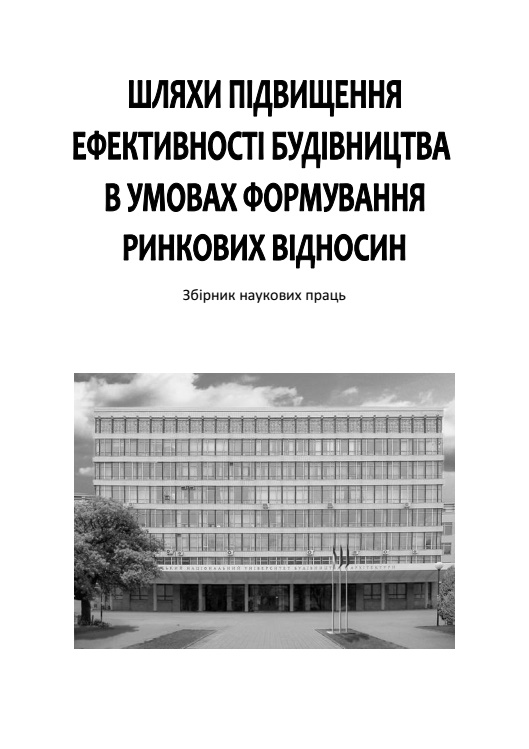Элементы методологии прогнозирования параметров плитных конструкций подземных частей зданий
DOI:
https://doi.org/10.32347/2707-501x.2014.32.216-224Keywords:
slab concrete structures, forecasting parameters, quality.Abstract
The method of levelness calculation for the buildings is defined. Factors and variables which depend on concrete levelness are described. The example of concrete levelness survey, processing of survey data and calculation is given. The results of the calculation are compared to the standard classification which is developed by American concrete institute. Using the above mentioned method of calculation it is possible to avoid defect of wrong levelness of concrete slab, decrease the duration of construction project, and increase the quality of works. The method of calculation would be useful to consider using appropriate survey and measuring equipment with following mathematic processing.
References
Армирование элементов железобетонных зданий. Пособие по проектированию. - М.: НИЦ Строительство, НИИЖБ им. А. А. Гвоздева, ЗАО КТБ НИИЖБ, 2007. - 182 с.
Бондаренко В. М. Железобетонные и каменные конструкции / В. М. Бондаренко. – М.: Высшая школа. 2007. - 888 с.
Габрусенко В. В. Влияние дефектов заводской технологии на прочность, жесткость и трещиностойкость железобетонных конструкций / В. В. Габрусенко. - Новосибирск : НГАСУ (Сибстрин), 2012. - 44 с. : ил., табл.
Комаров Д. Б. Устройство сверхплоских полов для складов – проблемы и решения / Д. Б. Комаров // Современный склад. – 2003. – № 3. – С.13 – 14.
Маилян Р. Л. Строительные конструкции / Р. Л. Маилян, Д. Р. Маилян, Ю. А. Веселев. Изд. 2-е. - Ростов-на-Дону: Феникс, 2005. - 880 с.
Малатян С. А. Арматура железобетонных конструкций / С. А. Малатян. - М.: Воентехлит, 2000. - С. 256.
Пособие по проектированию бетонных и железобетонных конструкций из тяжелого бетона без предварительного напряжения арматуры (к СП52-101-2003). - М.: ОАО ЦНИИПромзданий, 2005. - 214 с.
Рекомендации по защите монолитных жилых зданий от прогрессирующего обрушения. - М.: ГУПНИАЦ, 2005.
СП 63.13330.2012. Бетонные и железобетонные конструкции. Основные положения. Актуализированная редакция СНиП 52-01-2003. - М.: ФАУ ФЦС, 2012. - 155 с.
Тихонов И. Н. О нормировании анкеровки стержневой арматуры / И. Н. Тихонов, В. З. Мешков, Т. Н. Судаков // Бетон и железобетон. - 2006. - № 3. - С. 2 – 7.
ACI 302.1R-04. Guide for concrete and slab construction / American concrete institute. – USA, 2004. – 120р.
ASTM E 1155M-96 (Reapproved 2001). Standard test method for determining FF floor flatness and FL floor levelness numbers / Stanford linear accelerator center alignment engineering group. – USA, 2003. – 9 р.
ASTM E 1155-96 (Reapproved 2001). Standard test method for determining FF floor flatness and FL floor levelness numbers / ASTM International. – USA, 2003. – 9 р.
BAMTECâ Reinforcement Technology International -[Електроннийресурс] : cистемаВАМТЕС. -Режим доступу: http://www.bamtec.com/Bamtec_ru/index.htm.
Eurocode 2: Design of concrete structures. - Part 1-1: General rules and rules for buildings, 2004.
Williamson N. Superflat floor construction – how easy is it? / Neil Williamson // The concrete society. Concrete. – UK, 2005. – № 9. – Рр. 32 – 33.
http://www.allenface.com.
Downloads
How to Cite
Issue
Section
License
Copyright (c) 2020 I. Shumakov, V. Sekretnaia

This work is licensed under a Creative Commons Attribution 4.0 International License.
Authors who publish with this journal agree to the following terms:
- Authors retain copyright and grant the journal right of first publication with the work simultaneously licensed under a Creative Commons Attribution License that allows others to share the work with an acknowledgement of the work's authorship and initial publication in this journal.
- Authors are able to enter into separate, additional contractual arrangements for the non-exclusive distribution of the journal's published version of the work (e.g., post it to an institutional repository or publish it in a book), with an acknowledgement of its initial publication in this journal.
- Authors are permitted and encouraged to post their work online (e.g., in institutional repositories or on their website) prior to and during the submission process, as it can lead to productive exchanges, as well as earlier and greater citation of published work (See The Effect of Open Access).

